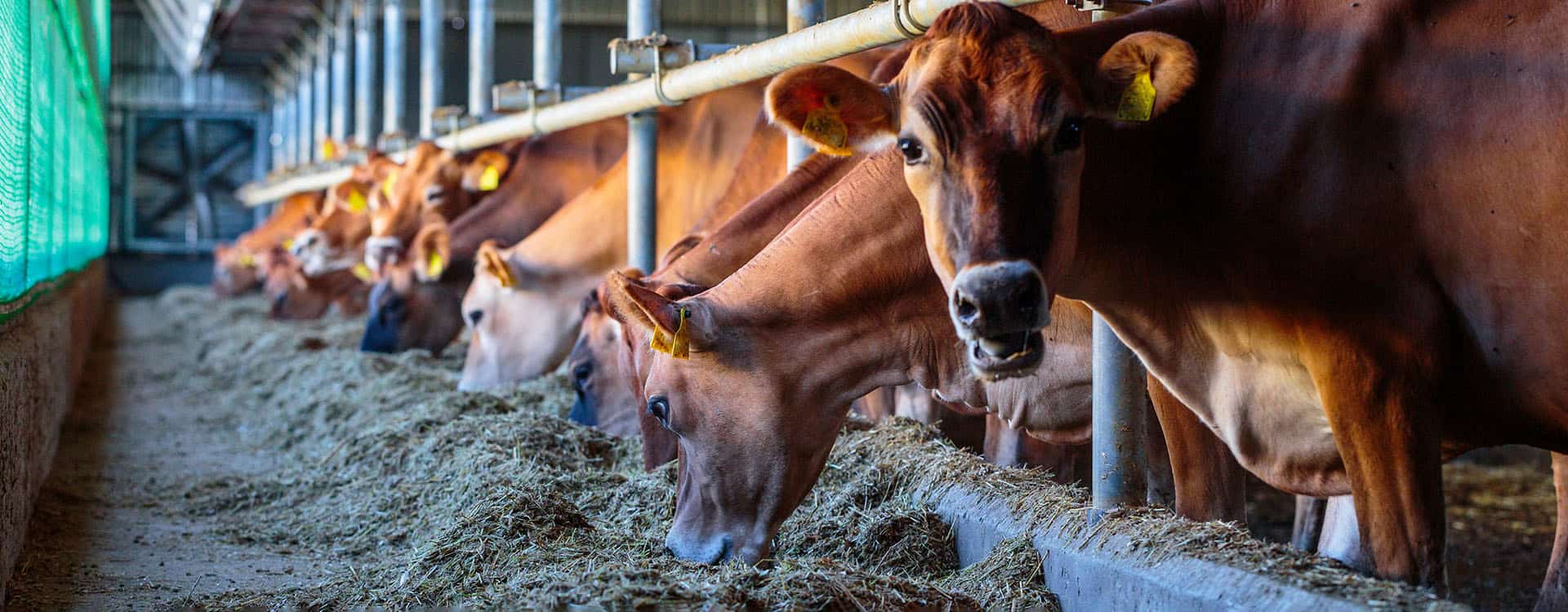WHAT KEEPS DAIRY COWS HEALTHY, WHAT MAKES THEM SICK?
A multitude of factors influences the health and wellbeing of farm animals, spanning from differences in the animal’s genes, to husbandry, from feeding to barn conditions, to the size or location of a farm. But which factors dominate where and how do they influence each other?
Hub researchers have distilled details from a large dataset of Austrian dairy farms. They define the health profiles for five types of dairy farms—and see considerable differences.
The results just appeared in Scientific Reports.
A BIG DATA ANALYSIS PURSUED AT THE HUB HELPS TO TRACK DOWN COMPLEX INTERACTIONS
We all know: Health—or disease—is a multidimensional process. The latest study conducted by the Hub scientists Caspar Matzhold and Peter Klimek in collaboration with Rinderzucht AUSTRIA, the University of Natural Resources and Life Sciences, Vienna (BOKU), and the University of Veterinary Medicine Vienna aimed at disentengling the complex interactions of factors leading to disease in dairy cows.
The scientists used a data set of 166 Austrian dairy farms with almost 6,000 cows. The data was compiled under the lead of co-author Christa Egger-Danner from ZuchtData Vienna in the earlier “Efficient cow” project.
“This is a truly unique dataset”, Christa proudly states. “From 2014 to 2016, 142 variables were meticulously recorded, from the genetic makeup and extensive health data of each single cow, to housing and husbandry conditions, to the type of fodder, milking methods, or the frequency of hoof care.”
A NEW METHOD FOR A UNIQUE DATASET
The CSH team assigned these variables to five categories: (1) environmental conditions (e.g., regional climate, altitude of the farm, frequency of rainfall), (2) feeding (e.g., grass [silage], concentrates, various fodder combinations; feeding hygiene), (3) milking systems (timing and frequency, technical aspects), (4) husbandry (e.g., organic farm Y/N, decisions about grazing for different animals, etc.), and (5) housing (stable conditions, tie-stall or free-stall housing, so-called high-bed or low-bed cubicles for resting).
To make sense of this multitude of information, the complexity scientists developed a new method that combines machine learning with statistical analysis. “This algorithm produced five clusters, each representing a specific type of farm, ranging from small high-altitude farms with alpine pasture to large high-performance dairy farms in the much warmer lowlands,” says Caspar, who was responsible for the data analysis as part of his doctoral thesis.
In the next step, the scientists attributed a risk profile for the most common diseases in dairy cows to each farm type. They plotted diseases such as acute or chronic mastitis (udder infection), bacterial infections of the uterus after birth, called metritis, a special metabolic disorder (ketosis), or lameness.
TOWARDS A SYSTEMIC UNDERSTANDING OF DISEASES
“In each farm type, different and specific clusters of factors influence the health of the animals,” Caspar explains. “Very generally speaking, we see that animals in cluster 1—the high-altitude mountain farms—are the healthiest. The most problems occur in clusters 4 and 5: the high-performance farms in the warmer, often windy lowlands where cows are kept inside with limited possibility of movement.”
The likelihood of disease in the latter clusters can be considerably be higher than in other clusters: Chronic mastitis, for example, occurs more likely in lowland farms (clusters 4 or 5) than in high-altitude.
Another example with interesting insights is the occurrence of lameness. The scientists found that opposing factors protect the animals from developing lame feet. “The risk is lower in free-stall and in tie-stall barns, which is somewhat of a contradiction,” says Caspar. “This means there must be other factors, too.” According to this analysis, one difference stems from the use of low-bed cubicles. Low-bed and high-bed cubicles are variants of specifically built set-back areas in a barn where the animals can lie on a soft ground.
“We saw that the use of low-bed cubicles reduces the risk for lameness,” says Caspar. Also influential are the floor mats used, or how often cows are allowed to graze.
DIGITAL SUPPORT FOR AUSTRIAN DAIRY FARMS
“This example already shows that it is not enough to pin down the risk of disease on individual factors,” says CSH project leader Peter Klimek. “Only when we analyze each disease with regard to a wide range of factors, a holistic picture will emerge.” Analyzing and interpreting such complex data sets is a major challenge. “But once we have determined the influence of individual factors, farmers are given an arsenal of options to specifically improve animal health and welfare on their farms,” Peter points out.
In fact, providing support to dairy farms is one of the overarching goals of the D4Dairy project, which was launched in 2018, and as part of which this paper was written (D4Dairy stands for “Digitalization, Data integration, Detection and Decision support in Dairying”.)
“Not every farmer can bring his or her animals to an alpine pasture in summer, and the spatial and climatic conditions vary greatly from region to region,” says Christa, the D4Dairy mastermind. “Farms therefore need support tailored to their very location and situation.”
D4Dairy aims at developing a digital support system that provides individualized suggestions, depending on the farmer’s inputs about barn conditions, fodder, farm type, and more. “The system could suggest things like a different feeding mixture, another type of resting areas, or new measures against the heat in barns—actually, we see that animals suffer from heat, and global warming will make things worse in the future,” says Christa.
Peter points to another overriding goal. “With publications like this, we are coming to a more holistic understanding of risk factors of disease and their interactions. In the D4Dairy project, we are developing the know-how for linking and integrating different data sets—which is always a problem with human data because of data privacy concerns. Insights form this project can certainly be of benefit for human medicine and health,” he concludes.
The study “A systematic approach to analyse the impact of farm-profiles on bovine health” by Caspar Matzhold, Jana Lasser, Christa Egger-Danner, Birgit Fuerst-Waltl, Thomas Wittek, Johann Kofler, Franz Steininger, and Peter Klimek just appeared in Scientific Reports.
Follow this link to our German press release.



